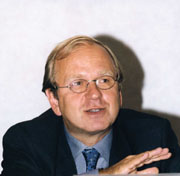
|
|
ERCIM News No.47, October 2001 [contents]
|
 Erkki Liikanen, Member of the European Commission, responsible for Enterprise and Information Society |
Ambient Intelligence in future EU Research EffortsThe European Commission’s proposal for the next Framework Programme (2003-2006) for Research and Development (FP6) was submitted to the Council of ministers and European Parliament in February 2001 and the related Specific programmes in May 2001. Information Society Technologies (IST) are one of the main priorities in the Commission proposal given their fundamental role in realising Europe’s objectives for the knowledge society as agreed at the Lisbon European Council of 2000, the Stockholm Council of 2001, and reflected in the e-Europe Action Plan. This renewed effort in RTD in IST is essential to ensure European leadership in the generic and applied technologies at the heart of the knowledge society, to improve European competitiveness and to enable all European citizens to benefit from the knowledge society. An important challenge for the academic and industrial research community in IST is to maintain the focus on medium to long-term objectives amid changing socio-economic contexts. We know that today only a small part of the world population, between 5 and 10 %, have access to IST applications and services. Costs, complexity, unavailability and unreliability are often preventing the further development and broader deployment of the knowledge and information society and the digital divide is widening. Even in developed countries, only a minor fraction of the possibilities that IST can offer, is actually used despite recent progress in the uptake of internet and mobile technology. As we start to understand the advantages and limitations of current technologies, research in IST should aim at new avenues that will not only extend the scope, functionality and efficiency of IST applications and services, but that will also make them available, in the most natural and trustful way, to citizens whoever they are, whatever their age is, anywhere and anytime. It must lead to a world where every child has access to personalised learning resources, where every patient can be treated within the comfort of his own home, where every engineer has the power of global computing resources at their fingertips, where every business is plugged into world-wide trading communities; and where every citizen is able to access public services anywhere, anytime. This is the world of ‘Ambient Intelligence’ that will, gradually but surely, emerge from research in IST. This is the vision that the IST priority in FP6 is following. It puts people at the centre of the development of future IST, ie, ‘design technologies for people and not make people adapt to technologies’. It aims at making technology invisible, embedded in our natural surrounding and present whenever we need it (eg, electricity) and at making interaction with the technology simple, effortless and using all our senses. This vision sustains and extends the objectives of the European Commission’s eEurope 2002 Action Plan of bringing IST applications and services to everyone, every home, school and to all businesses. The trend towards an Ambient Intelligence landscape provides a clear opportunity for European industry to build on, and strengthen its leading position in areas such as mobile communications, consumer electronics and home appliances, embedded software and microelectronics. It will help reinforce the competitiveness of all industrial sectors. Europe can build on pioneering work in the field such as the EU funded initiative on the ‘disappearing computer’ and on industrial and technological achievements. A main step forward is already brought in mobile/wireless technologies with the 2.5 and 3G mobile systems. These provide anywhere access to applications and services from a non-PC platform and for the normal ‘man and woman on the street’. Wearable mobile devices that incorporate interfaces making use of our senses such as speech and gesture are currently under development. Cars already encompass an expanse of IST devices that we use and to which we have access without knowing. A sustained research effort is needed to accelerate the progress in key areas such as advanced interfaces, broadband mobile, wireless and optical communications, distributed and embedded computing technologies and knowledge handling techniques. It is also required in order to push the limits of miniaturisation and minimise the costs and power consumption of microelectronic components and to explore new materials, such as organic flexible material for displays and sensors so that they can be placed anywhere and take any shape. Europe can not afford to miss the unique opportunities offered by this next generation of IST, either in social or economic terms. The stake is even higher given the role of IST in all other research and engineering fields and their impact on the realisation of the European Research Area. We hope that the support to IST in FP6 will provide further impetus to the members of ERCIM and the whole research community, from industry and academia, to pull together their effort and build coherent approaches to realise the vision. |